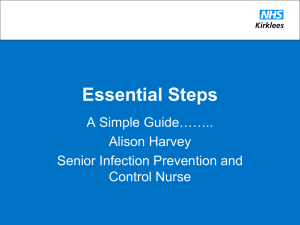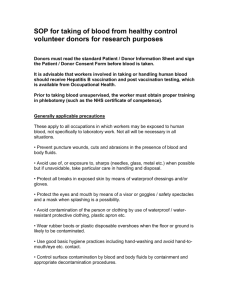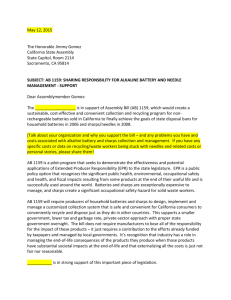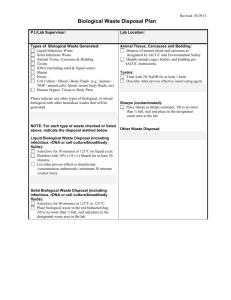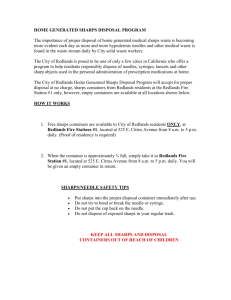18 Policy on the Disposal of Sharps
advertisement
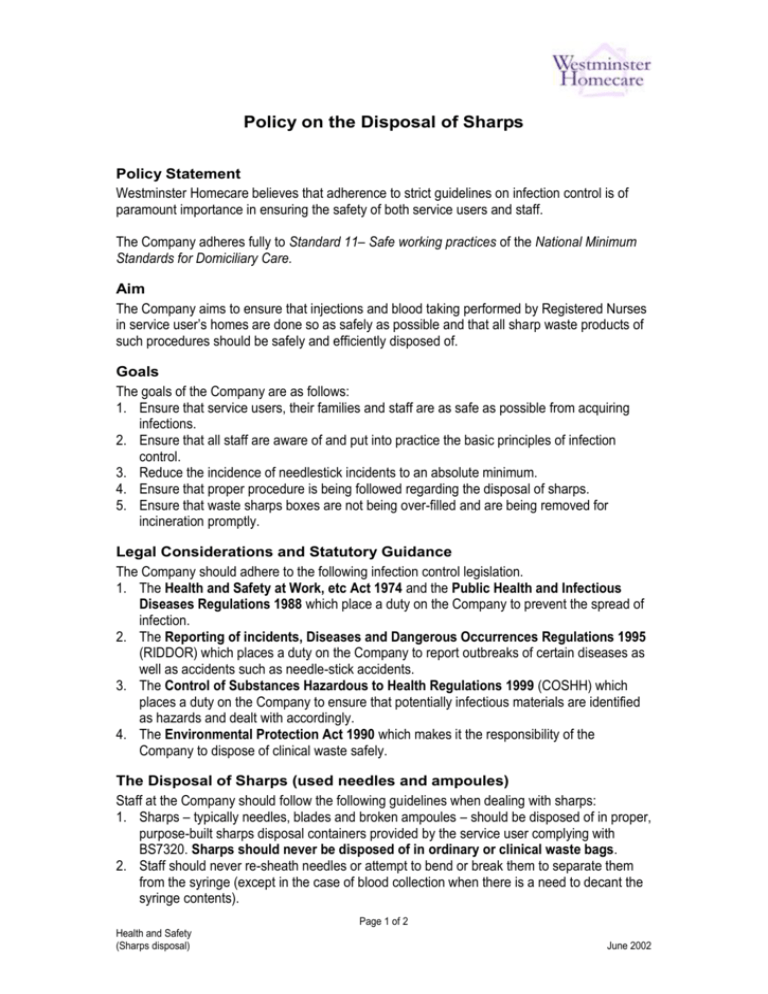
Policy on the Disposal of Sharps Policy Statement Westminster Homecare believes that adherence to strict guidelines on infection control is of paramount importance in ensuring the safety of both service users and staff. The Company adheres fully to Standard 11– Safe working practices of the National Minimum Standards for Domiciliary Care. Aim The Company aims to ensure that injections and blood taking performed by Registered Nurses in service user’s homes are done so as safely as possible and that all sharp waste products of such procedures should be safely and efficiently disposed of. Goals The goals of the Company are as follows: 1. Ensure that service users, their families and staff are as safe as possible from acquiring infections. 2. Ensure that all staff are aware of and put into practice the basic principles of infection control. 3. Reduce the incidence of needlestick incidents to an absolute minimum. 4. Ensure that proper procedure is being followed regarding the disposal of sharps. 5. Ensure that waste sharps boxes are not being over-filled and are being removed for incineration promptly. Legal Considerations and Statutory Guidance The Company should adhere to the following infection control legislation. 1. The Health and Safety at Work, etc Act 1974 and the Public Health and Infectious Diseases Regulations 1988 which place a duty on the Company to prevent the spread of infection. 2. The Reporting of incidents, Diseases and Dangerous Occurrences Regulations 1995 (RIDDOR) which places a duty on the Company to report outbreaks of certain diseases as well as accidents such as needle-stick accidents. 3. The Control of Substances Hazardous to Health Regulations 1999 (COSHH) which places a duty on the Company to ensure that potentially infectious materials are identified as hazards and dealt with accordingly. 4. The Environmental Protection Act 1990 which makes it the responsibility of the Company to dispose of clinical waste safely. The Disposal of Sharps (used needles and ampoules) Staff at the Company should follow the following guidelines when dealing with sharps: 1. Sharps – typically needles, blades and broken ampoules – should be disposed of in proper, purpose-built sharps disposal containers provided by the service user complying with BS7320. Sharps should never be disposed of in ordinary or clinical waste bags. 2. Staff should never re-sheath needles or attempt to bend or break them to separate them from the syringe (except in the case of blood collection when there is a need to decant the syringe contents). Page 1 of 2 Health and Safety (Sharps disposal) June 2002 3. Sharps disposal boxes should never be over-filled and no attempt should ever be made to force waste into a full container. 4. Sharps boxes must always be place out of the way of service users or visitors, especially from children who may be attracted by the bright colours. 5. Boxes should always be placed where they are accessible to the job in hand and should be ‘taken to the task’ wherever possible. Staff should avoid situations where they have to cross rooms with unsheathed sharps to get a disposal box. 6. Sharps boxes are designed with lids that can be closed in routine use and sealed when full. In between each use lids should be closed but not sealed and only opened immediately prior to use. 7. When full boxes should be sealed, marked as hazardous waste and labelled with the client’s details. 8. Used, filled boxes should be stored securely until collected for incineration. Needlestick or Sharps Injuries In the event of an injury with a used or potentially contaminated needle staff should do the following: 1. Wash area immediately and encourage bleeding if the skin is broken. 2. Apply a dressing. 3. Report to Branch manager immediately and fill in an incident from. 4. Report immediately to the GP or Accident and Emergency. Reporting The Reporting of Injuries, Diseases and Dangerous Occurrences Regulations 1995 obliges the Company to report needlestick injuries to the Health and Safety Executive (HSE). Records of any such incident must be kept specifying dates and times and a completed disease report from must be sent to the HSE. Infection Control Training All new staff should be encouraged to read the policy on Infection Control and Food Handling as part of their induction process. Existing staff should be offered training to National Training Organisation standards covering basic information about infection control. In-house training sessions should be conducted at least annually and all relevant staff should attend. Infection Control training co-ordinator: __________________________________________ Signed: ________________________________________________________ Date: ________________________________________________________ Policy Review Date: ________________________________________________________ Page 2 of 2 Health and Safety (Sharps disposal) June 2002


